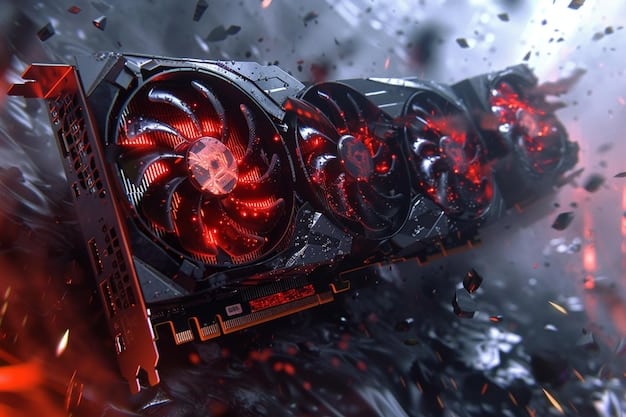AMD & Game Devs: Shaping PC Gaming’s Future in 2025

AMD’s collaboration with game developers is revolutionizing PC gaming by focusing on advanced technologies like FidelityFX Super Resolution (FSR) and ray tracing, leading to enhanced performance, visual fidelity, and immersive gaming experiences expected to define the future of gaming in 2025.
AMD’s collaboration with game developers: How it’s Shaping the Future of PC Gaming in 2025 represents a pivotal shift in how games are designed and experienced, focusing on maximizing performance and visual fidelity for an ever-demanding audience. This partnership is not just about hardware; it’s about creating a synergistic ecosystem where software and hardware evolve together.
The Evolution of AMD’s Gaming Partnerships
AMD has a long history of collaborating with game developers to push the boundaries of PC gaming. These partnerships have evolved from simple hardware optimizations to deep, integrated efforts that shape the very core of game design.
Early Collaborations and Their Impact
In the early days, AMD’s partnerships primarily focused on optimizing game performance for their hardware. This involved working with developers to ensure that games ran smoothly on AMD processors and graphics cards.
The Shift Towards Integrated Development
Over time, AMD’s approach shifted towards more integrated development efforts. This meant working closely with developers from the early stages of game development to incorporate AMD technologies and features.
- 🛠️ Deep integration allows for better optimization.
- 🚀 Enables the development of new technologies.
- 🤝 Ensures compatibility and performance.
- 🌟 Enhances the overall gaming experience.
These early collaborations laid the groundwork for today’s more sophisticated partnerships, which are driving innovation in PC gaming. Understanding this evolution is crucial to appreciating the extent of AMD’s current influence.

In conclusion, AMD’s gaming partnerships have evolved significantly over the years. From basic hardware optimizations to deeply integrated development efforts, these collaborations have played a crucial role in shaping the PC gaming landscape, setting the stage for future innovations.
FidelityFX Super Resolution (FSR): A Game Changer
FidelityFX Super Resolution (FSR) is one of AMD’s most significant contributions to PC gaming. This technology has revolutionized the way games are rendered, offering gamers a way to boost performance without sacrificing visual quality.
How FSR Works
FSR is a spatial upscaling technology that allows games to be rendered at a lower resolution and then upscaled to a higher resolution. This reduces the workload on the GPU, resulting in higher frame rates and smoother gameplay.
Benefits of FSR for Game Developers
For game developers, FSR offers several key benefits. It allows them to target a wider range of hardware configurations, ensuring that more gamers can enjoy their titles. It also reduces the performance overhead, freeing up resources for other visual enhancements.
- 🚀 Improves performance on lower-end hardware.
- 🖼️ Maintains visual quality through advanced upscaling.
- 💻 Easier integration into existing game engines.
- 🎮 Broadens the audience reach for games.
FSR has quickly become a staple in modern PC games, largely due to its ease of integration and the tangible benefits it provides to both developers and gamers. As the technology continues to evolve, its impact on gaming will only grow.
In summary, FidelityFX Super Resolution (FSR) is a game-changing technology that enhances gaming performance without compromising visual quality. Its widespread adoption and ease of integration make it a valuable tool for game developers, ensuring that more players can enjoy their games.
Ray Tracing and AMD: Visual Realism Redefined
Ray tracing is a rendering technique that simulates the way light behaves in the real world, creating incredibly realistic and immersive visuals. AMD has been working closely with game developers to bring ray tracing to more PC games.
AMD’s Approach to Ray Tracing
AMD’s approach to ray tracing involves both hardware and software optimizations. Their Radeon RX 6000 and 7000 series graphics cards feature dedicated ray tracing hardware, while their FidelityFX suite includes tools and technologies to optimize ray tracing performance.
The Impact of Ray Tracing on Game Design
Ray tracing has a profound impact on game design, allowing developers to create more realistic and visually stunning environments. This can lead to more immersive and engaging gaming experiences.

The integration of ray tracing is not just about visual fidelity; it also influences gameplay. Realistic lighting and shadows can affect how players navigate and interact with the game world, adding new layers of depth and strategy.
In conclusion, AMD’s efforts in ray tracing technology are redefining visual realism in PC gaming. By combining hardware and software optimizations, AMD enables developers to create more immersive and visually stunning game environments, enhancing the overall gaming experience for players.
Optimizing Games for AMD Hardware in 2025
As we look ahead to 2025, optimizing games for AMD hardware will become even more critical. This involves taking advantage of AMD’s latest technologies and features to ensure that games run smoothly and look their best.
Leveraging AMD’s Latest Technologies
Game developers can leverage AMD’s latest technologies, such as FSR and ray tracing, to optimize their games for AMD hardware. This can involve using AMD’s developer tools and libraries to integrate these technologies into their games.
Collaborative Optimization Efforts
AMD works closely with game developers to provide support and guidance on optimizing their games for AMD hardware. This can involve sharing best practices, providing technical assistance, and offering access to early hardware and software.
- 🤝 Joint development projects.
- 💻 Tailoring games for AMD architectures.
- ✅ Performance testing and feedback.
- 🌟 Ensuring compatibility and stability.
By working together, AMD and game developers can ensure that games are optimized for AMD hardware, delivering the best possible gaming experience to players.
In summary, optimizing games for AMD hardware in 2025 and beyond will be crucial for delivering exceptional gaming experiences. By leveraging AMD’s latest technologies and engaging in collaborative optimization efforts, developers can ensure their games run smoothly and look stunning on AMD-powered PCs.
The Role of Open Source in AMD’s Gaming Strategy
Open source plays a significant role in AMD’s gaming strategy. By embracing open-source technologies, AMD fosters collaboration, innovation, and transparency within the gaming community.
AMD’s Open-Source Initiatives
AMD has a number of open-source initiatives aimed at supporting game developers. This includes open-source drivers, libraries, and tools that developers can use to optimize their games for AMD hardware.
Benefits of Open Source for Developers
Open source provides developers with access to a wealth of resources and tools that can help them create better games. It also fosters collaboration and knowledge sharing within the gaming community.
Open source can also lead to faster innovation. By allowing developers to contribute to and improve AMD’s technologies, AMD can accelerate the pace of innovation and deliver new features and capabilities to gamers more quickly.
In conclusion, open source is a key component of AMD’s gaming strategy. By embracing open-source technologies, AMD fosters collaboration, innovation, and transparency within the gaming community, ultimately benefiting both developers and gamers.
Future Trends in AMD and Game Developer Collaboration
Looking ahead, several key trends are likely to shape the future of AMD and game developer collaboration. These include the increasing importance of AI, the rise of cloud gaming, and the continued evolution of rendering technologies.
The Increasing Importance of AI
AI is becoming increasingly important in game development, with applications ranging from AI-powered characters to AI-driven content creation. AMD is working with game developers to integrate AI technologies into their games, taking advantage of AMD’s powerful hardware and software capabilities.
The Rise of Cloud Gaming
Cloud gaming is another trend that is likely to shape the future of AMD and game developer collaboration. As more gamers turn to cloud gaming services, AMD is working with cloud providers to optimize their hardware and software for cloud gaming workloads.
- ☁️ Optimizing game streaming performance.
- 🎮 Enhancing the cloud gaming experience.
- 💻 Supporting remote rendering technologies.
- 🚀 Scaling performance for cloud infrastructure.
These future trends promise to further enhance the gaming experience, leveraging the collaboration between AMD and game developers to push the boundaries of what’s possible.
In conclusion, the future of AMD and game developer collaboration is poised to be shaped by trends like AI, cloud gaming, and evolving rendering technologies. These advancements will create new opportunities for innovation and further enhance the gaming experience for players worldwide.
| Key Point | Brief Description |
|---|---|
| 🎮 FSR Technology | Enhances game performance by upscaling lower-resolution images, maintaining visual quality. |
| ✨ Ray Tracing | Creates realistic lighting and shadows, enhancing visual depth and immersion. |
| 🤝 Dev Collaboration | AMD partners with game developers for optimized game experiences and hardware compatibility. |
| 🤖 AI Integration | AI is increasingly used to enhance character behavior and content creation in games. |
Frequently Asked Questions
▼
AMD FSR is an upscaling technology that boosts frame rates in games by rendering at a lower resolution and then upscaling the image, providing a performance lift without significant visual quality loss.
▼
Ray tracing simulates realistic lighting and shadows, creating more immersive and visually stunning game environments, enhancing the overall realism and depth of the gaming experience.
▼
Collaboration ensures that games are optimized for AMD hardware, maximizing performance and visual fidelity, and allows for better integration of AMD technologies into game design.
▼
Open source fosters collaboration and innovation, providing developers with tools and resources to optimize games for AMD hardware, leading to faster development and better performance.
▼
AI is being used for enhanced character behavior, content creation, and overall game optimization, leveraging AMD’s hardware capabilities to deliver more immersive and dynamic gaming experiences.
Conclusion
AMD’s collaborative efforts with game developers are significantly shaping the future of PC gaming in 2025. Through technologies like FSR and ray tracing, coupled with strategic partnerships and a commitment to open source, AMD is driving innovation and enhancing the gaming experience for players worldwide.





